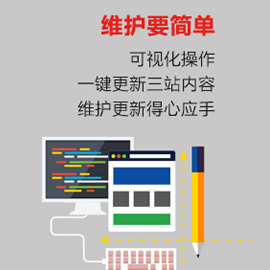在React中如何優(yōu)雅的處理事件響應(yīng)詳解
前言

創(chuàng)新互聯(lián)公司專注為客戶提供全方位的互聯(lián)網(wǎng)綜合服務(wù),包含不限于成都網(wǎng)站制作、網(wǎng)站設(shè)計(jì)、海勃灣網(wǎng)絡(luò)推廣、小程序開發(fā)、海勃灣網(wǎng)絡(luò)營銷、海勃灣企業(yè)策劃、海勃灣品牌公關(guān)、搜索引擎seo、人物專訪、企業(yè)宣傳片、企業(yè)代運(yùn)營等,從售前售中售后,我們都將竭誠為您服務(wù),您的肯定,是我們最大的嘉獎(jiǎng);創(chuàng)新互聯(lián)公司為所有大學(xué)生創(chuàng)業(yè)者提供海勃灣建站搭建服務(wù),24小時(shí)服務(wù)熱線:18982081108,官方網(wǎng)址:www.chinadenli.net
本文主要給大家介紹的是關(guān)于React處理事件響應(yīng)的相關(guān)內(nèi)容,分享出來供大家參考學(xué)習(xí),下面來一起看看詳細(xì)的介紹吧。
React中定義一個(gè)組件,可以通過React.createClass或者ES6的class。本文討論的React組件是基于class定義的組件。采用class的方式,代碼結(jié)構(gòu)更加清晰,可讀性強(qiáng),而且React官方也推薦使用這種方式定義組件。
處理事件響應(yīng)是Web應(yīng)用中非常重要的一部分。React中,處理事件響應(yīng)的方式有多種。
一、使用箭頭函數(shù)
先上代碼:
//代碼1
class MyComponent extends React.Component {
render() {
return (
<button onClick={()=>{console.log('button clicked');}}>
Click
</button>
);
}
}當(dāng)事件響應(yīng)邏輯比較復(fù)雜時(shí),再把所有的邏輯直接寫在onClick的大括號(hào)內(nèi),就會(huì)導(dǎo)致render函數(shù)變得臃腫,不容易直觀地看出組件render出的元素結(jié)構(gòu)。這時(shí),可以把邏輯封裝成組件的一個(gè)方法,然后在箭頭函數(shù)中調(diào)用這個(gè)方法。
如下所示:
//代碼2
class MyComponent extends React.Component {
constructor(props) {
super(props);
this.state = {number: 0};
}
handleClick() {
this.setState({
number: ++this.state.number
});
}
render() {
return (
<div>
<div>{this.state.number}</div>
<button onClick={()=>{this.handleClick();}}>
Click
</button>
</div>
);
}
}這種方式最大的問題是,每次render調(diào)用時(shí),都會(huì)重新創(chuàng)建一個(gè)事件的回調(diào)函數(shù),帶來額外的性能開銷,當(dāng)組件的層級(jí)越低時(shí),這種開銷就越大,因?yàn)槿魏我粋€(gè)上層組件的變化都可能會(huì)觸發(fā)這個(gè)組件的render方法。當(dāng)然,在大多數(shù)情況下,這點(diǎn)性能損失是可以不必在意的。這種方式也有一個(gè)好處,就是不需要考慮this的指向問題,因?yàn)檫@種寫法保證箭頭函數(shù)中的this指向的總是當(dāng)前組件。
二、使用組件方法
代碼先:
//代碼3
class MyComponent extends React.Component {
constructor(props) {
super(props);
this.state = {number: 0};
this.handleClick = this.handleClick.bind(this);
}
handleClick() {
this.setState({
number: ++this.state.number
});
}
render() {
return (
<div>
<div>{this.state.number}</div>
<button onClick={this.handleClick}>
Click
</button>
</div>
);
}
}這種方式的好處是每次render,不會(huì)重新創(chuàng)建一個(gè)回調(diào)函數(shù),沒有額外的性能損失。需要注意的是,使用這種方式要在構(gòu)造函數(shù)中為事件回調(diào)函數(shù)綁定this: this.handleClick = this.handleClick.bind(this) ,否則handleClick中的this是undefined。這是因?yàn)镋S6 語法的緣故,ES6 的 Class 構(gòu)造出來的對(duì)象上的方法默認(rèn)不綁定到 this 上,需要我們手動(dòng)綁定。每次都手動(dòng)綁定this是不是有點(diǎn)蛋疼?好吧,讓我們來看下一種方式。
三、屬性初始化語法(property initializer syntax)
使用ES7的 property initializers,代碼可以這樣寫:
//代碼4
class MyComponent extends React.Component {
constructor(props) {
super(props);
this.state = {number: 0};
}
handleClick = () => {
this.setState({
number: ++this.state.number
});
}
render() {
return (
<div>
<div>{this.state.number}</div>
<button onClick={this.handleClick}>
Click
</button>
</div>
);
}
}哈哈,再也不用手動(dòng)綁定this了。但是你需要知道,這個(gè)特性還處于試驗(yàn)階段,默認(rèn)是不支持的。如果你是使用官方腳手架Create React App 創(chuàng)建的應(yīng)用,那么這個(gè)特性是默認(rèn)支持的。你也可以自行在項(xiàng)目中引入babel的transform-class-properties插件獲取這個(gè)特性支持。
四、回調(diào)函數(shù)傳參問題
事件的回調(diào)函數(shù)默認(rèn)是會(huì)被傳入一個(gè)事件對(duì)象Event作為參數(shù)的。如果我想傳入其他參數(shù)給回調(diào)函數(shù)應(yīng)該怎么辦呢?
使用第一種方式的話很簡單,直接傳就可以了:
//代碼5
class MyComponent extends React.Component {
constructor(props) {
super(props);
this.state = {
list: [1,2,3,4],
current: 1
};
}
handleClick(item,event) {
this.setState({
current: item
});
}
render() {
return (
<ul>
{this.state.list.map(
(item)=>(
<li className={this.state.current === item ? 'current':''}
onClick={(event) => this.handleClick(item, event)}>{item}
</li>
)
)}
</ul>
);
}
}使用第二種方式的話,可以把綁定this的操作延遲到render中,在綁定this的同時(shí),綁定額外的參數(shù):
//代碼6
class MyComponent extends React.Component {
constructor(props) {
super(props);
this.state = {
list: [1,2,3,4],
current: 1
};
}
handleClick(item) {
this.setState({
current: item
});
}
render() {
return (
<ul>
{this.state.list.map(
(item)=>(
<li className={this.state.current === item ? 'current':''}
onClick={this.handleClick.bind(this, item)}>{item}
</li>
)
)}
</ul>
);
}
}使用第三種方式,解決方案和第二種基本一致:
//代碼7
class MyComponent extends React.Component {
constructor(props) {
super(props);
this.state = {
list: [1,2,3,4],
current: 1
};
}
handleClick = (item) => {
this.setState({
current: item
});
}
render() {
return (
<ul>
{this.state.list.map(
(item)=>(
<li className={this.state.current === item ? 'current':''}
onClick={this.handleClick.bind(undefined, item)}>{item}
</li>
)
)}
</ul>
);
}
}不過這種方式就有點(diǎn)雞肋了,因?yàn)殡m然你不需要通過bind函數(shù)綁定this,但仍然要使用bind函數(shù)來綁定其他參數(shù)。
關(guān)于事件響應(yīng)的回調(diào)函數(shù),還有一個(gè)地方需要注意。不管你在回調(diào)函數(shù)中有沒有顯式的聲明事件參數(shù)Event,React都會(huì)把事件Event作為參數(shù)傳遞給回調(diào)函數(shù),且參數(shù)Event的位置總是在其他自定義參數(shù)的后面。例如,在代碼6和代碼7中,handleClick的參數(shù)中雖然沒有聲明Event參數(shù),但你依然可以通過arguments[1]獲取到事件Event對(duì)象。
總結(jié)
三種綁定事件回調(diào)的方式,第一種有額外的性能損失;第二種需要手動(dòng)綁定this,代碼量增多;第三種用到了ES7的特性,目前并非默認(rèn)支持,需要Babel插件的支持,但是寫法最為簡潔,也不需要手動(dòng)綁定this。推薦使用第二種和第三種方式。
好了,以上就是這篇文章的全部內(nèi)容了,希望本文的內(nèi)容對(duì)大家的學(xué)習(xí)或者工作能帶來一定的幫助,如果有疑問大家可以留言交流,謝謝大家對(duì)創(chuàng)新互聯(lián)的支持。
網(wǎng)站欄目:在React中如何優(yōu)雅的處理事件響應(yīng)詳解
標(biāo)題URL:http://www.chinadenli.net/article22/pesdcc.html
成都網(wǎng)站建設(shè)公司_創(chuàng)新互聯(lián),為您提供面包屑導(dǎo)航、建站公司、小程序開發(fā)、網(wǎng)站收錄、外貿(mào)網(wǎng)站建設(shè)、企業(yè)網(wǎng)站制作
聲明:本網(wǎng)站發(fā)布的內(nèi)容(圖片、視頻和文字)以用戶投稿、用戶轉(zhuǎn)載內(nèi)容為主,如果涉及侵權(quán)請(qǐng)盡快告知,我們將會(huì)在第一時(shí)間刪除。文章觀點(diǎn)不代表本網(wǎng)站立場(chǎng),如需處理請(qǐng)聯(lián)系客服。電話:028-86922220;郵箱:631063699@qq.com。內(nèi)容未經(jīng)允許不得轉(zhuǎn)載,或轉(zhuǎn)載時(shí)需注明來源: 創(chuàng)新互聯(lián)

- 掌握這些漲粉技巧讓你微信公眾號(hào)漲粉不再慢? 2014-06-29
- 公眾號(hào)的留言功能是如何申請(qǐng)的 2015-03-01
- 公眾號(hào)軟文代寫價(jià)格怎么算? 2014-02-09
- 微信公眾號(hào)進(jìn)展一般,應(yīng)該怎么營銷? 2015-09-06
- 微信公眾號(hào)改版應(yīng)該考慮什么? 2014-05-19
- 微信公眾號(hào)的精準(zhǔn)粉絲如何定位? 2014-05-25
- 【微信公眾號(hào)運(yùn)營目的】微信公眾號(hào)賺錢方向 2022-05-25
- 如何用微信公眾號(hào)做企業(yè)營銷推廣? 2015-08-15
- 微信微信公眾號(hào)如何留住粉絲? 2014-06-07
- 微信公眾號(hào)的五個(gè)排版技巧! 2014-05-23
- 同樣是公眾號(hào)的編輯你到底差在哪里? 2014-02-26
- 微信公眾號(hào)營銷推廣需要了解的內(nèi)容是什么? 2015-09-06